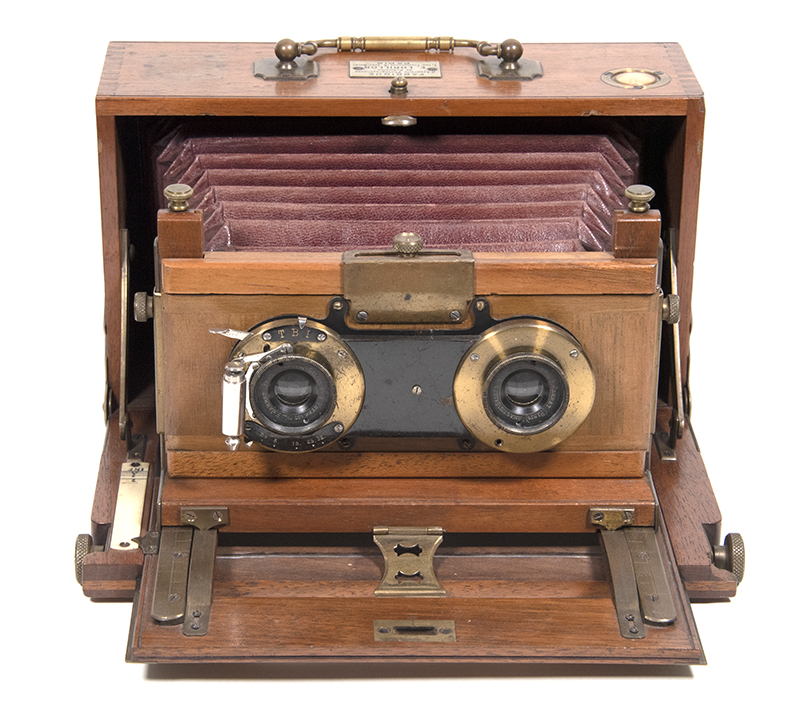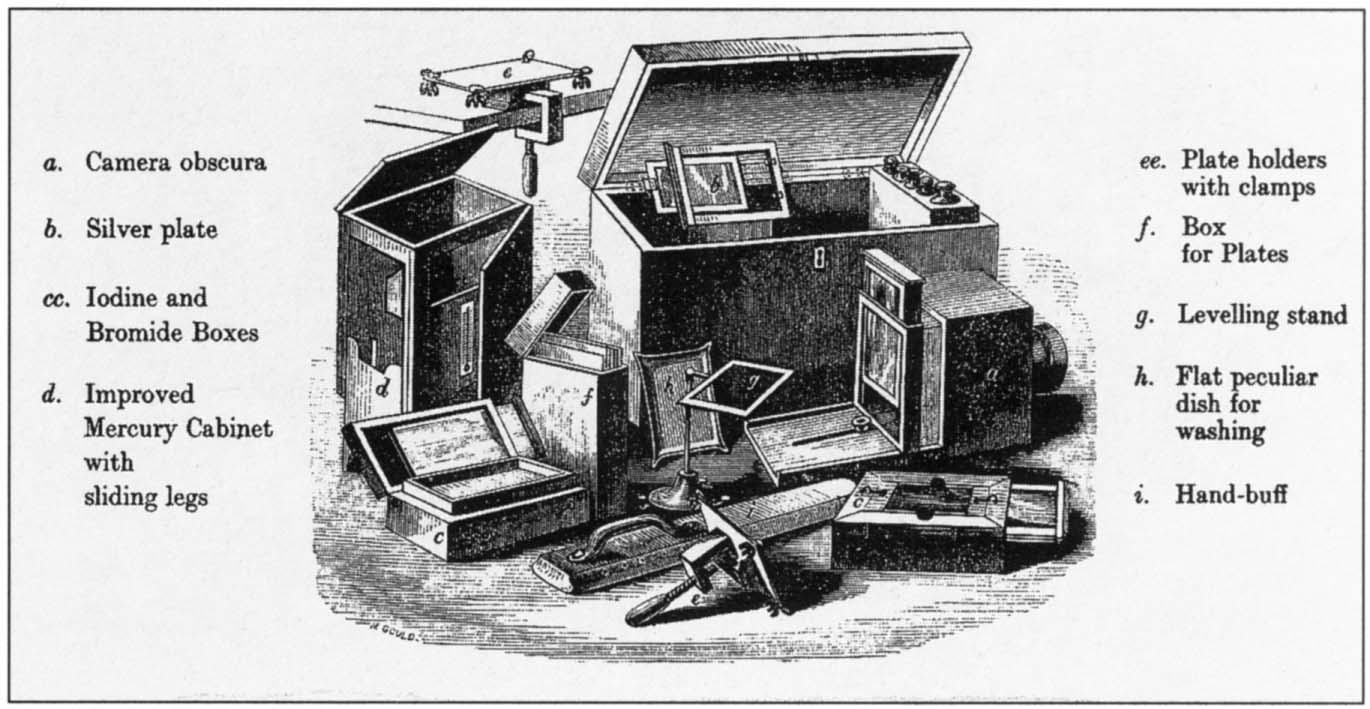Форма входа |
|---|
Поиск по сайту |
|---|
Категории | |||||
|---|---|---|---|---|---|
|
Помощь сайту |
|---|
Amazon |
|---|
Mini chat |
|---|
Статистика |
|---|
Онлайн всего: 1 Гостей: 1 Пользователей: 0 |
ART БИБЛИОТЕКА
СТАТЬИ
| Главная » Статьи » Статьи по Фотографии » История Фотографии |
| В категории материалов: 9 Показано материалов: 1-9 |
Сортировать по: Дате · Названию · Рейтингу · Комментариям · Просмотрам
 ENGLISH HYBRID STYLE FIELD CAMERA. 1875. R & J Beck were established as a telescope and microscope makers from 1843, well before photography became available to the majority of people. By the 1880s they were exporting lenses in large quantities to America. This camera is numbered 586; and earlier one, number 420, held by The Museum of the History of Science in Oxford, was used by the father of Lawrence of Arabia, and probably by Lawrence himself when at school. Using 420 as a known date referent, I have dated mine to 1875. It has several early and sophisticated features which never caught on with later makers, probably because of their extreme high quality and consequent expense. The R & J Beck signature is engraved into the wood, which was Becks' way of labelling, as opposed to the brass or ivory nameplates used by most makers. The unique hybrid design slightly departs from McKellens's patent, as stamped in the front woodwork, by having rear focusing on rack and pinion, while the front standard is fixed but can be extended manually forward for double extension. It came to me with a completely fractured front fork, which was restorable, and with scrap square cornered burgundy bellows which were unrestorable and were replaced by black chamfered corner bellows of a slightly later period. |
 OLDING CAMERA. 1910. A high-quality, drop-baseboard camera by a
top-class maker, made in leather-covered aluminium at a time when wood
and brass cameras were still co-existing happily with the relatively
newly introduced metal folding ones. Compact folding by means of
trellis struts at either side, with rising and cross front movements.
Lever operated, scale-focusing mechanism, on baseboard, 2 yards to
infinity. Direct vision viewfinder. Ross Homocentric 5in/f6.3 lens. |
|
E. Lorillon Stereo Plate Camera This is a nicely crafted mahogany and brass stereo camera designed to take two square 75mm photographs on a glass plate. The manufacturer was E. Lorillon of Paris, France. I like the way the camera folds into a compact unit. I find it odd that when folded, the lenses are not completely covered and protected. The brass fittings have interesting detailing. I don't know the date of manufacture and would like to hear from
anyone who
does. My guess is ca 1910. The shutter has three settings - time,
bulb and instantaneous. The aperture is adjustable from f7.5 to f32.
The lenses are marked: Anastig Gallos 8x9 Foyer 107mm F. Jarret
(Paris). |
|
In the late 1800s and early 1900s, we saw a boom in the design and production of cameras concealed in everyday objects. Many of these cameras were sold for detective works, whereas some (like the matchbox camera) were designed specifically for spying activities. For a fantastic collection of vintage cameras, it’s hard to beat George Eastman House’s online archive: Link |
|
Do All of a Galloping Horse’s Hooves Leave the Ground? In 1872, Eadweard Muybridge, a British-born photographer, was hired by Leland Stanford (who later founded the university), to settle a question (some people say a $25,000 bet) whether there was a point in a horse’s full gallop where all four hooves were off the ground. Muybridge arranged 12 cameras alongside a race track and attached a string to the camera switches across the track. When the horse ran through the string, it triggered the shot. The series of photographs showed that indeed, all four hooves leave the ground when the horse is in full gallop. Muybridge went on to develop systems and techniques to photograph motion of people and animal. |
|
Louis Jacques Mande DAGUERRE (1787-1851)
The daguerreotype process was the first practicable method of obtaining permanent images with a camera. The man who gave his name to the process and perfected the method of producing direct positive images on a silver-coated copper plate was Louis Jacques Mande Daguerre, a French artist and scenic painter. Daguerre had began experimenting with ways of fixing the images formed by the camera obscura around 1824, but in 1829 he entered into partnership with Joseph Nicephore Niepce (1765-1833), a French amateur scientist and inventor who, in 1826, had succeeded in securing a picture of the view from his window by using a a camera obscura and a pewter plate coated with bitumen. Niepce called his picture-making process heliography ("sun drawing"), but although he had managed to produce a permanent image using a camera, the exposure time was around 8 hours. Niepce later abandoned pewter plates in favour of silver-plated sheets of copper and discovered that the vapour from iodine reacted with the silver coating to produce silver iodide, a light sensitive compound. After the death of Niepce in 1833, Daguerre continued to experiment with copper plates coated with silver iodide to produce direct positive pictures. Daguerre discovered that the latent image on an exposed plate could be brought out or "developed" with the fumes from warmed mercury. The use of mercury vapour meant that photographic images could be produced in twenty to thirty minutes rather than hours. In 1837, Daguerre found a way of "fixing" the photographic images with a solution of common salt. Two years later, he followed the suggestion of Sir John Herschel (1792-1871) and adopted hyposulphate of soda (now thiosulphate of soda ) as the fixing agent. Daguerre began making successful pictures using his improved process from 1837. On 19th August,1839, at a meeting in Paris, the Daguerreotype Process was revealed to the world. In England, Richard Beard (1801-1885), a former coal merchant and patent speculator, bought the patent to Alexander Wolcott's mirror camera and employed the services of John Frederick Goddard (1795-1866), a chemist, to find a way of reducing exposure times to less than a few minutes, thereby making it possible to take daguerreotype portraits. On 23rd March 1841, Richard Beard opened England�s first daguerreotype portrait studio in London's Regent Street. In June 1841, Beard purchased from Daguerre the patent rights to the daguerreotype process in England.
|
 Полагаю все видели при входе в ЖЖ ссылку вот на этот вот пост? Лично я не назвала бы подобного рода фотографии "ретро-бредом". Просто каждое время диктует свои нравы и.......... наоборот. **хм...может я жестокая какая то?....** На самом деле с точки зрения истории фотографии это очень интересная тема и стоило бы её поподробнее или хотя бы слегка изучить. Посему предлагаю вам несколько ссылок. На Flickr-е: °1° - °2° - °3° В целом по инету: °1° - °2° - Thanatos Archive.. The Museum of Mourning Photography & Memorial Practice (MoMP). ...................пожалуй хватит......... |
|
Безусловно, изобретение фотографии изменило мир.
Появление и развитие фотографии изменило взгляд человека на мир и
жизнь, повлияло на то, каким способом люди стали видеть, преображая
этот процесс от просто фиксирования реальности до умения ее
конструировать на композиционной плоскости. Изобретение и развитие
фотографии – это не просто техническое новшество, как и ряд других,
созданных в пышном девятнадцатом веке. Фотография – это новый способ
взаимодействия человека и мира.
|
|
|




